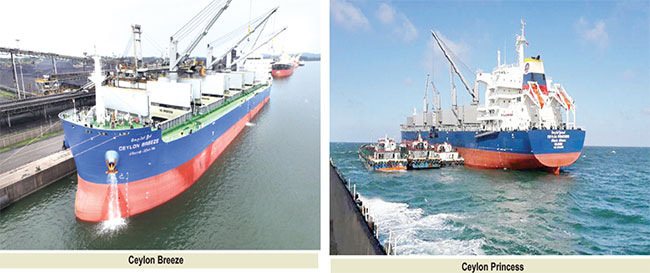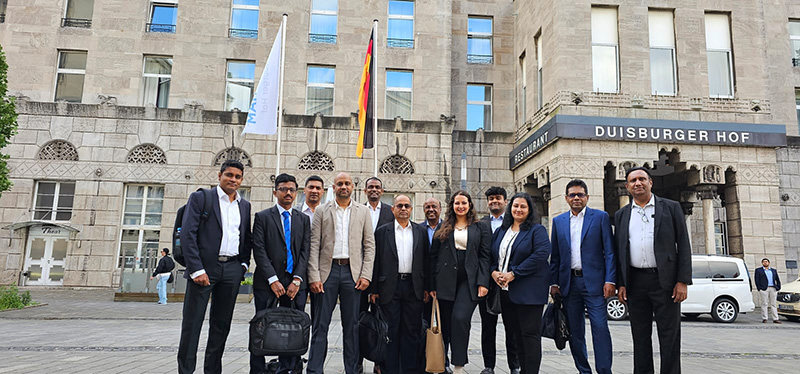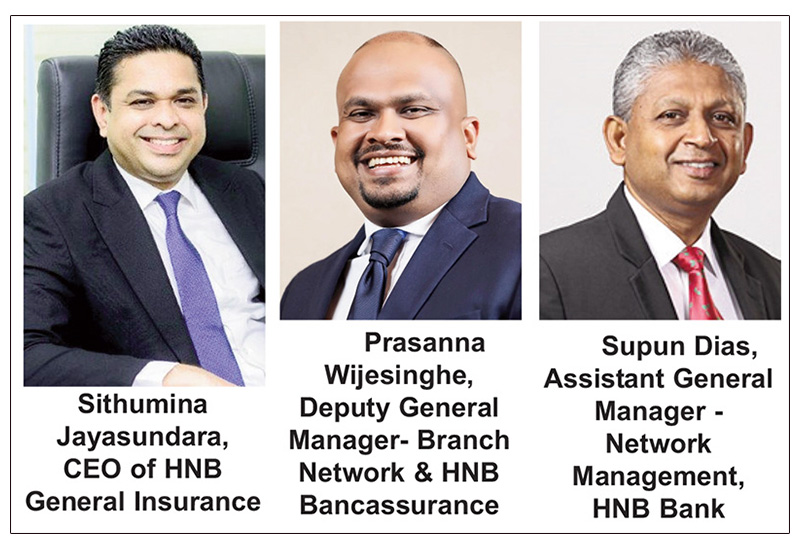Business
Ceylon Shipping Corporation turns tables on its financial performance

Reports loss reduction of Rs. 1.15 billion in two years
Posts Rs. 636 million profit in fist 8 months of FY 2021/22
If CSC’s fleet size is increased, country can save millions of dollars spent on ship chartering, says chairman
by Sanath Nanayakkare
The Ceylon Shipping Corporation (CSC) has made an impressive turnaround in its fortunes from a loss-making State Owned Enterprise (SOE) to a profit making SOE within two years.
In the Financial Year 2020/21, CSC has posted a profit of Rs. 636 million in the first eight months of financial year 2021/22 , changing the situation completely different from the losses it made in 2018/19 (Rs. 1,523 million) and in 2019/20 (Rs. 1,085 million) which had caused problems for them.
 CSC Chairman, Wineendra S. Weeraman, told The Island Financial Review that the profit curve of CSC was a well thought out one.
CSC Chairman, Wineendra S. Weeraman, told The Island Financial Review that the profit curve of CSC was a well thought out one.
“When I assumed duties as chairman of CSC in December 2019, nobody was interested in taking over the helm at the CSC under such dismal financial circumstances,” he said.
Weeraman said that he first gave priority to settling a loan of USD 75 million taken from the People’s Bank by the previous management for purchasing two ships.
“This loan was on a Treasury guarantee and I decided to clear all arrears because I didn’t want to carry it forward paying a huge interest on the loan capital. In the accounts, I saw that we had an outstanding payment amounting to Rs.1,400 million which had to be collected from Lanka Coal Company – the procurement entity of the CEB. Through an official process, I was able to recover these funds and use it to repay that loan. Whatever I had to pay I paid and I took the decision to charter out our ships at the opportune moment despite the threat of Covid-19. Those were the key decisions I took and that is how we are making profits now,” he said.
Further speaking he said:
“Currently the main business of CSC is delivering coal to Norochcholai power plant. In this connection, CSC deals with Lanka Coal Company and the Ceylon Electricity Board (CEB). The CEB charters our two bulk carriers ‘Ceylon Breeze’ and ‘Ceylon Princess’ each with 62,000 deadweight tonnage, to bring in coal to Sri Lanka from South Africa. The CEB pays us in Sri Lankan rupees when they charter our vessels, but when they charter foreign vessels for the purpose, they pay in US dollars.”
“CSC brings in one third of the total coal requirement for Norochcholai Power Plant. We can help save a massive amount of US dollar payments made as ship chartering costs if CSC has its own fleet to deliver the entire requirement of coal.”
“At the height of Covid-19, despite concerns among experts that we should keep the two ships at anchorage, upon verifying of IMO regulations and the advice of Harbour Master and Medical Officer of the Sri Lanka Ports Authority, I decided to send our ships to sea and bring in much needed foreign currency to the country, without leaving the ships idling at sea incurring losses for six months. With that operation, we were able to bring in 3 million USD within about 6 months.”
“When we charter a ship to transport coal to Norochcholai Plant, procured through Lanka Coal Company, the charter hire alone costs between US$ 1.3 million and 2.0 million on top of other costs for each charter. If we have another four vessels in our fleet, we can prevent this foreign currency outflow happening time after time.”
“If we bring the fleet up to six vessels with a tanker or two, we can bring in the entire supply of coal, rice, sugar and even petroleum products without chartering international vessels over an infinite number of years. How many millions do we pay for transportation of fuel and other commodities? Being the purchaser of these products, we should be able to dictate the terms of their transportation. We can ask them to use our vessels. If the government says all fuel imports to Sri Lanka needs to be carried on CSC vessels, then we can save a lot of millions of dollars.”
“The policymakers of the government should support us in this regard. They should support key government organisations such as CSC and put some muscle into its capacity to make it more productive in its operations and empower it to support the economy of the country in a more robust way. We have made requests to policymakers pertaining to this objective including the former chairman of CSC who could assist us in fund arrangement,” he said.
“CSC’s annual turnover is about Rs. 3.8-4.0 billion whereas Sri Lanka Port’s Authority’s annual turnover is about Rs. 55 billion. Comparatively speaking, CSC is also contributing to the economy in a notable way with the limited resources it has. The CSC has great potential for growth if it gets the necessary policy support.”
“CSC employs 125 staff in-house. On each vessel we have about 22-23 crew members – that’s about 46 on both vessels and we have a reserve pool of crew for crew changes. Our salary structure is very competitive with that of international shipping lines. We pay a ship master about USD 8,500- 9000 per month. We have to pay such salaries to ensure deployment of qualified and skilled people on board our vessels. However, the upside here is that the entire crew is Sri Lankan”.
“Before Covid when we chartered out our ships to international parties during the off-season, we earned USD 8000-13,000 per day per ship. With the spread of initial Covid wave, these prices came down to USD 6,500-7,500. After the second wave of Covid, the freight rates skyrocketed to about USD 35,000-40,000. So this is the best period for the global shipping industry and we should make the best out of this situation for CSC.”
“The greatest difficulty we have with the CEB is that we fight with them to get priority to us in charter services and they also prefer to give it to outsiders upon finding one single fault that could easily be rectified. And even after providing the services for them, they take months and years to pay our dues. Then we can’t operate maintaining a positive balance sheet.”
“I would like to urge the policymakers and top officials to take bold policy decisions to beef up the fleet of CSC.”
Talking about his future plans he said:
“There are several projects which I intend to start here. There were negotiations in 2017 – with Bangladesh Shipping Corporation to operate a feeder service here. If you take Port of Colombo, its capacity is 7 million TEUs. In Bangladesh it is 3.5 million. Twenty percent of their cargo is coming to Colombo. That is about 700,000 TEUs. Bangladesh ports are very congested. Ship owners don’t like to go there because it takes days to reach a terminal. If we sign this bilateral agreement, they are going to save on the number of days spent on transportation of their cargo. If we can sign it, CSC will be able to earn about USD 2 million per year. The SLPA also will earn from it when TEUs are brought to the Port of Colombo. It will be a win-win-win situation for all parties.”
“Bunker prices are very high here compared to Singapore. Sometimes we don’t get the bunkering business unless the prices fluctuate in a competitive manner to ship operators. If we supply them bunker off-shore or out of the port, they will prefer to get oil at a lesser price. I have submitted a proposal for a floating bunker as well.”
“And then the ferry service between Colombo and Tuticorin which was started in 2011. I am planning to resume this service. Not only Tuticorin, we can try various other ports in India.”
“Going further, I have a plan to arrange medium size cruise vessels between Colombo, Male and Goa. If we arrange these tours then everybody will find them exciting and enjoy these tours bringing us revenue.”
“CSC wants to get involved in passenger transportation as well. I have signed an agreement with Sail Lanka Yachting Group, a global company that builds yachts in Sri Lanka. They are already operating from the Colombo Port City Marina. They have agreed to manufacture bigger ships to partner with CSC’s plans for passenger transportation.”
“These are plans for the future and I have submitted them to the policymakers. If we want to make a maritime hub here, these things should be facilitated.”
“Ship repairing is another area. I also wait in queue to get CSC ships repaired. In addition to Colombo Dockyard, we need to build another dockyard, ideally in Trincomalee.”
“Finally, We need to be mindful of Sagarmala Programme which is underway in India targeted to culminate by 2035. It is designed across areas of port modernisation, new port development, port connectivity enhancement and port-linked industrialisation. One day it is going to affect us. So we need to equip all critical installations here to stay in the business and thrive in the new maritime sector emerging in the region. I appeal to the policymakers and top officials of the government to support CSC with bold policy-making for its exponential growth, bolstering key business verticals of the industry at the same time.”
Business
AHK Sri Lanka champions first-ever Sri Lankan delegation at Drupa 2024

The Delegation of German Industry and Commerce in Sri Lanka (AHK Sri Lanka) proudly facilitated the first-ever Sri Lankan delegation’s participation at Drupa 2024, the world’s largest trade fair for the printing industry and technology. Held after an eight-year hiatus, Drupa 2024 was a landmark event, marking significant advancements and opportunities in the global printing industry.
AHK Sri Lanka played a pivotal role in organising and supporting the delegation, which comprised 17 members from the Sri Lanka Association for Printers (SLAP), representing eight companies from the commercial, newspaper, stationery printing, and packaging industries. This pioneering effort by AHK Sri Lanka not only showcased the diverse capabilities of Sri Lanka’s printing sector but also facilitated vital bilateral discussions with key stakeholders from the German printing industry.
Business
Unveiling Ayugiri: Browns Hotels & Resorts sets the stage for a new era in luxury Ayurveda Wellness

In a captivating reimagining of luxury wellness tourism, Browns Hotels & Resorts proudly unveiled the exquisite Ayugiri Ayurveda Wellness Resort Sigiriya. This momentous occasion, celebrated amidst a vibrant and serene grand opening on the 6th of June, heralds a new chapter in the Ayurveda wellness tourism landscape in Sri Lanka. Nestled amidst 54 acres of unspoiled natural splendour, Ayugiri features 22 exclusive suites and stands out as the only luxury Ayurveda wellness resort in the country offering plunge pools in every room, rendering it truly one-of-a-kind.
The grand opening of Ayugiri Ayurveda Wellness Resort was an enchanting event, where guests were captivated by the melodies of flutists and violinists resonating through Sigiriya’s lush landscapes. As traditional drummers and dancers infused the air with vibrant energy, Browns Hotels & Resorts’ CEO, Eksath Wijeratne, Kotaro Katsuki, Acting Ambassador for the Embassy of Japan and General Manager, Buwaneka Bandara, unveiled the resort’s new logo, marking a significant moment witnessed by distinguished guests from the French Embassy, Ayurveda and wellness enthusiasts along with officials from the Sigiriya area, LOLC Holdings and Browns Group.
“Our strategic expansion into wellness tourism with Ayugiri Ayurveda Wellness Resort Sigiriya symbolises a significant milestone for Browns Hotels & Resorts. Wellness tourism has consistently outperformed the overall tourism industry for over a decade, reflecting a growing global interest in travel that goes beyond leisure to offer rejuvenation and holistic well-being. By integrating the timeless wisdom of Ayurveda with modern luxury, we aim to set a new standard in luxury wellness tourism in Sri Lanka. Whether your goal is prevention, healing, or a deeper connection to inner harmony, Ayugiri offers a sanctuary for holistic well-being” stated Eksath Wijeratne.
Ayugiri encapsulates the essence of life, inspired by the lotus flower held by the graceful queens of the infamous Sigiriya frescoes. Just as the lotus emerges from the murky depths, untainted and serene,
Ayugiri invites guests on a journey of purity and rejuvenation, harmonised with a balance of mind, body and spirit, the essence of nature, echoes of culture and the wisdom of ancient Ayurvedic healing.
Business
HNB General Insurance recognized as Best General Bancassurance Provider in Sri Lanka 2024

HNB General Insurance, one of Sri Lanka’s leading general insurance providers, has been honored as the Best General Bancassurance Provider in Sri Lanka 2024 by the prestigious Global Banking and Finance Review – UK.
The esteemed accolade underscores HNB General Insurance’s unwavering commitment to excellence and its outstanding performance in the field of bancassurance. Through dedication and hard work, the HNB General Insurance team has continuously endeavored to deliver innovative insurance solutions, cultivate strong relationships with banking partners, and provide unparalleled service to customers nationwide. This recognition is a testament to the team’s dedication and relentless pursuit of excellence in the bancassurance business.
“We are honored to receive this prestigious award, which reflects our team’s tireless efforts and dedication to delivering value-added insurance solutions and exceptional service through our bancassurance partnerships,” said Sithumina Jayasundara, CEO of HNB General Insurance. “This recognition reaffirms our position as a trusted insurance provider in Sri Lanka and motivates us to continue striving for excellence in serving our customers and communities.”





















